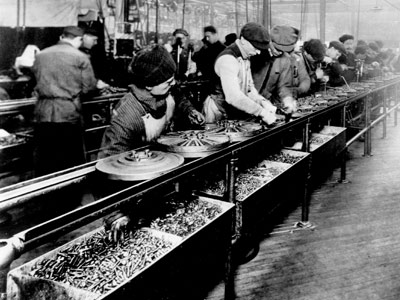This past weekend the NY Times had an in-depth piece on some of the decisions and processes surrounding the manufacture of Apple's iPhone. The excellent piece is absolutely worth your time and attention, as it provides some fascinating insights into the requirements, expectations, and outcomes from a high-volume, high-tech, design, development, and manufacturing process today.
Suffice to say some of the commonly-held assumptions about United States firms inability to compete for most of the value-added supply chain and manufacturing processes for the iPhone are validated - US universities are not producing enough skilled engineering talent chief among them. But some other assumptions, mainly the sheer cost advantage provided by outsourcing less skilled assembly tasks to lower wage locations like China, while not completely dismissed, are at least downplayed as a key decision driver for Apple in the Times piece.
In the piece the labor cost differential is estimated to contribute only a relatively small percentage of the iPhone's eventual market price stating: "However, various academics and manufacturing analysts estimate that because labor is such a small part of technology manufacturing, paying American wages would add up to $65 to each iPhone’s expense."
While $65 per phone is still relevant, it isn't necessarily enough on its own to drive decisions to outsource. So if the labor cost savings from assembly in China isn't the primary decision driver then why is the vast majority of the iPhone manufacturing process conducted outside of the United States?
Well if you believe the Times reporting it's almost completely about speed and flexibility. To me the most telling example comes from Apple's 2007 decision to re-design the device's screen just weeks before the launch date. A major change like this, so close to the delivery date would normally result in a missed product delivery, bad PR, unhappy customers, and perhaps even opened the door for a competitor to beat Apple to this market.
So what happened? From the Times piece:
One former (Apple) executive described how the company relied upon a Chinese factory to revamp iPhonemanufacturing just weeks before the device was due on shelves. Apple had redesigned the iPhone’s screen at the last minute, forcing an assembly line overhaul. New screens began arriving at the plant near midnight.
A foreman immediately roused 8,000 workers inside the company’s dormitories, according to the executive. Each employee was given a biscuit and a cup of tea, guided to a workstation and within half an hour started a 12-hour shift fitting glass screens into beveled frames. Within 96 hours, the plant was producing over 10,000 iPhones a day.
“The speed and flexibility is breathtaking,” the executive said. “There’s no American plant that can match that.”
Let that story sink in a bit. A veritable legion of workers, that were on-site 24/7, and that could be roused to work at a moment's notice to start cranking out the newly re-designed iPhones. I am sure the former Apple executive is right that the speed and flexibility in this example can't be matched by any American firm.
And likely no American firm ever will, at least for the foreseeable future. Because having thousands of workers living on the manufacturing site, and that could be roused to work in the middle of the night with a biscuit and some tea doesn't align with any American's conception of what modern work should be. Does that sound like the kind of workforce your firm would want to assemble?
But when you think about it a little, the idea of thousands of people, all living together in very controlled circumstances, available to work at a moment's notice for extremely low wages, and lacking any real power to do much about their situation does sound a little familiar.
It sounds a little like prison.